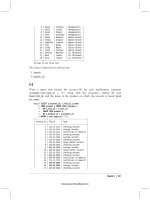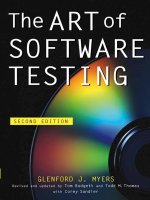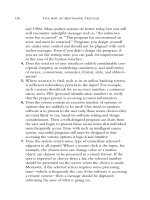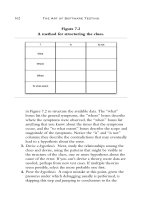The art of software testing second edition phần 10 pot
Bạn đang xem bản rút gọn của tài liệu. Xem và tải ngay bản đầy đủ của tài liệu tại đây (181.17 KB, 21 trang )
public static void main (String [] args) {
//Initialize class object to work with
check4Prime check = new check4Prime();
try{
//Check arguments and assign value to input variable
check.checkArgs(args);
//Check for Exception and display help
}catch (Exception e) {
System.out.println("Usage: check4Prime x");
System.out.println(" where 0<=x<=1000");
System.exit(1);
}
//Check if input is a prime number
if (check.primeCheck(input))
System.out.println("Yippeee " + input + " is a prime number!");
else
System.out.println("Bummer " + input + " is NOT a prime number!");
} //End main
//Calculates prime numbers and compares it to the input
public boolean primeCheck (int num) {
double sqroot = Math.sqrt(max); // Find square root of n
//Initialize array to hold prime numbers
boolean primeBucket [] = new boolean [max+1];
//Initialize all elements to true, then set non-primes to false
for (int i=2; i<=max; i++) {
primeBucket[i]=true;
}
214 Appendix A
bappa.qxd 4/29/04 4:38 PM Page 214
//Do all multiples of 2 first
int j=2;
for (int i=j+j; i<=max; i=i+j) { //start with 2j as 2 is prime
primeBucket[i]=false; //set all multiples to false
}
for (j=3; j<=sqroot; j=j+2) { // do up to sqrt of n
if (primeBucket[j]==true) { // only do if j is a prime
for (int i=j+j; i<=max; i=i+j) { // start with 2j as j is prime
primeBucket[i]=false; // set all multiples to false
}
}
}
//Check input against prime array
if (primeBucket[num] == true) {
return true;
}else{
return false;
}
}//end primeCheck()
//Method to validate input
public void checkArgs(String [] args) throws Exception{
//Check arguments for correct number of parameters
if (args.length != 1) {
throw new Exception();
}else{
//Get integer from character
Integer num = Integer.valueOf(args[0]);
input = num.intValue();
Appendix A 215
bappa.qxd 4/29/04 4:38 PM Page 215
//If less than zero
if (input < 0) //If less than lower bounds
throw new Exception();
else if (input > max) //If greater than upper bounds
throw new Exception();
}
}
}//End check4Prime
2. check4PrimeTest.java
Requires the JUnit API, junit.jar
To compile:
&> javac -classpath .:junit.jar check4PrimeTest.java
To run:
&> java -cp .:junit.jar check4PrimeTest
Examples:
Starting test
Time: 0.01
OK (7 tests)
Test finished
216 Appendix A
bappa.qxd 4/29/04 4:38 PM Page 216
Source code:
//check4PrimeTest.java
//Imports
import junit.framework.*;
public class check4PrimeTest extends TestCase{
//Initialize a class to work with.
private check4Prime check4prime = new check4Prime();
//constructor
public check4PrimeTest (String name) {
super(name);
}
//Main entry point
public static void main(String[] args) {
System.out.println("Starting test ");
junit.textui.TestRunner.run(suite());
System.out.println("Test finished ");
} // end main()
//Test case 1
public void testCheckPrime_true() {
assertTrue(check4prime.primeCheck(3));
}
//Test cases 2,3
public void testCheckPrime_false() {
assertFalse(check4prime.primeCheck(0));
assertFalse(check4prime.primeCheck(1000));
}
Appendix A 217
bappa.qxd 4/29/04 4:38 PM Page 217
//Test case 7
public void testCheck4Prime_checkArgs_char_input() {
try {
String [] args= new String[1];
args[0]="r";
check4prime.checkArgs(args);
fail("Should raise an Exception.");
} catch (Exception success) {
//successful test
}
} //end testCheck4Prime_checkArgs_char_input()
//Test case 5
public void testCheck4Prime_checkArgs_above_upper_bound() {
try {
String [] args= new String[1];
args[0]="10001";
check4prime.checkArgs(args);
fail("Should raise an Exception.");
} catch (Exception success) {
//successful test
}
} // end testCheck4Prime_checkArgs_upper_bound()
//Test case 4
public void testCheck4Prime_checkArgs_neg_input() {
try {
String [] args= new String[1];
args[0]="-1";
check4prime.checkArgs(args);
fail("Should raise an Exception.");
} catch (Exception success) {
//successful test
}
}// end testCheck4Prime_checkArgs_neg_input()
218 Appendix A
bappa.qxd 4/29/04 4:38 PM Page 218
//Test case 6
public void testCheck4Prime_checkArgs_2_inputs() {
try {
String [] args= new String[2];
args[0]="5";
args[1]="99";
check4prime.checkArgs(args);
fail("Should raise an Exception.");
} catch (Exception success) {
//successful test
}
} // end testCheck4Prime_checkArgs_2_inputs
//Test case 8
public void testCheck4Prime_checkArgs_0_inputs() {
try {
String [] args= new String[0];
check4prime.checkArgs(args);
fail("Should raise an Exception.");
} catch (Exception success) {
//successful test
}
} // end testCheck4Prime_checkArgs_0_inputs
//JUnit required method.
public static Test suite() {
TestSuite suite = new TestSuite(check4PrimeTest.class);
return suite;
}//end suite()
} //end check4PrimeTest
Appendix A 219
bappa.qxd 4/29/04 4:38 PM Page 219
bappa.qxd 4/29/04 4:38 PM Page 220
APPENDIX B
Prime Numbers
Less Than 1,000
2357111317192329
31 37 41 43 47 53 59 61 67 71
73 79 83 89 97 101 103 107 109 113
127 131 137 139 149 151 157 163 167 173
179 181 191 193 197 199 211 223 227 229
233 239 241 251 257 263 269 271 277 281
283 293 307 311 313 317 331 337 347 349
353 359 367 373 379 383 389 397 401 409
419 421 431 433 439 443 449 457 461 463
467 479 487 491 499 503 509 521 523 541
547 557 563 569 571 577 587 593 599 601
607 613 617 619 631 641 643 647 653 659
661 673 677 683 691 701 709 719 727 733
739 743 751 757 761 769 773 787 797 809
811 821 823 827 829 839 853 857 859 863
877 881 883 887 907 911 919 929 937 941
947 953 967 971 977 983 991 997
221
bappb.qxd 4/29/04 4:38 PM Page 221
bappb.qxd 4/29/04 4:38 PM Page 222
Glossary
black-box testing. A testing approach whereby the program is con-
sidered as a complete entity and the internal structure is ignored.
Test data are derived solely from the application’s specification.
bottom-up testing. A form of incremental module testing in which
the terminal module is tested first, then its calling module, and
so on.
boundary-value analysis. A black-box testing methodology that
focuses on the boundary areas of a program’s input domain.
branch coverage. See decision coverage.
cause-effect graphing. A technique that aids in identifying a set of
high-yield test cases by using a simplified digital-logic circuit (com-
binatorial logic network) graph.
code inspection. A set of procedures and error-detection techniques
used for group code readings that is often used as part of the test-
ing cycle to detect errors. Usually a checklist of common errors is
used to compare the code against.
condition coverage. A white-box criterion in which one writes
enough test cases that each condition in a decision takes on all pos-
sible outcomes at least once.
data-driven testing. See black-box testing.
decision/condition coverage. A white-box testing criterion that
requires sufficient test cases that each condition in a decision takes
on all possible outcomes at least once, each decision takes on all
possible outcomes at least once, and each point of entry is invoked
at least once.
223
bgloss.qxd 4/29/04 4:38 PM Page 223
decision coverage. A criterion used in white-box testing in which
you write enough test cases that each decision has a true and a false
outcome at least once.
desk checking. A combination of code inspection and walk-through
techniques that the program performs at the user’s desk.
equivalence partitioning. A black-box methodology in which each
test case should invoke as many different input conditions as possi-
ble in order to minimize the total number of test cases; you should
try to partition the input domain of a program into equivalent
classes such that the test result for an input in a class is representa-
tive of the test results for all inputs of the same class.
exhaustive input testing. A criterion used in black-box testing in
which one tries to find all errors in a program by using every pos-
sible input condition as a test case.
external specification. A precise description of a program’s behavior
from the viewpoint of the user of a dependent system component.
facility testing. A form of system testing in which you determine if
each facility (a.k.a. function) stated in the objectives is imple-
mented. Do not confuse facility testing with function testing.
function testing. The process of finding discrepancies between the
program and its external specification.
incremental testing. A form of module testing whereby the module
to be tested is combined with already-tested modules.
input/output testing. See black-box testing.
JVM. Acronym for Java Virtual Machine.
LDAP. Acronym for Lightweight Directory Application Protocol.
logic-driven testing. See white-box testing.
multiple-condition coverage. A white-box criterion in which one
writes enough test cases that all possible combinations of condition
outcomes in each decision, and all points of entry, are invoked at
least once.
nonincremental testing. A form of module testing whereby each
module is tested independently.
performance testing. A system test in which you try to demon-
strate that an application does not meet certain criteria, such as
224 Glossary
bgloss.qxd 4/29/04 4:38 PM Page 224
response time and throughput rates, under certain workloads or
configurations.
random-input testing. The processes of testing a program by ran-
domly selecting a subset of all possible input values.
security testing. A form of system testing whereby you try to com-
promise the security mechanisms of an application or system.
stress testing. A form of system testing whereby you subject the pro-
gram to heavy loads or stresses. Heavy stresses are considered peak
volumes of data or activity over a short time span. Internet applica-
tions where large numbers of concurrent users can access the appli-
cations typically require stress testing.
system testing. A form of higher-order testing that compares the
system or program to the original objectives. To complete system
testing, you must have a written set of measurable objectives.
testing. The process of executing a program, or a discrete program
unit, with the intent of finding errors.
top-down testing. A form of incremental module testing in which
the initial module is tested first, then the next subordinate module,
and so on.
usability testing. A form of system testing in which the human-
factor elements of an application are tested. Components generally
checked include screen layout, screen colors, output formats, input
fields, program flow, spellings, and so on.
volume testing. A type of system testing of the application with large
volumes of data to determine whether the application can handle
the volume of data specified in its objectives. Volume testing is not
the same as stress testing.
walkthrough. A set of procedures and error-detection techniques
for group code readings that is often used as part of the testing cycle
to detect errors. Usually a group of people act as a “computer” to
process a small set of test cases.
white-box testing. A type of testing in which you examine the inter-
nal structure of a program.
Glossary 225
bgloss.qxd 4/29/04 4:38 PM Page 225
bgloss.qxd 4/29/04 4:38 PM Page 226
A
Acceptance testing, 128, 144
with Extreme Programming,
179, 185
Application programming inter-
face (API), 177
Application server, 196
Architecture testing, 204
Automated debugging tools,
158, 160
Automated testing
Automated test tools, 120
B
Backtrack debugging, 168
Basic e-commerce architecture,
194
Beck, Kent, 188
Big-bang testing, 105
Black-box testing, 9–11, 44,
205. See also Equivalence
partitioning
methodologies of, 52
vs. white-box testing, 114
BONUS module, 94, 101
boundary value analysis of,
102
Boolean logic network, 85
Bottom-up testing, 116–119
disadvantages, 117
vs. top-down testing, 109
Boundary conditions, 59
Boundary-value analysis, 44, 59,
196
compared to equivalence class
testing, 59
input boundaries for, 102
program example, 60, 61
weakness of, 65
Branch coverage, 45
Branch decision testing, excep-
tions to successful testing, 46
Branching statement, Java code
sample, 47, 48
Browser compatibility testing,
198, 204
Brute force debugging, 158
problems with, 160
Business layer, 196, 201
business layer testing, 199,
205–208
Business tier, 196
C
C++ compiler testing, 10
Case stories, 179
227
INDEX
bindex.qxd 4/30/04 9:55 AM Page 227
Cause-effect graph:
converting to decision table,
81
definition, 66
symbols, 68
used to derive test cases, 71
Cause-effect graphing, 44,
65–88, 149
described, 85
for program specification
analysis, 86
Check4Prime.java, 186, 213
Check4PrimeTest.java, 186, 216
Checklists, 27–38
comparison errors, 31
computation errors, 30
control flow errors, 32
data-declaration errors, 29
data reference errors, 27
input/output errors, 35
inspection error, 36
interface errors, 34
Client-server applications, 193
Client-server architecture,
194–196, 201
Code inspection, 22, 24–26
benefits, 26
checklist for, 27
process, 26
time required, 26
Code walkthrough, 38
Comparison errors, 31
Compatibility/configuration/
conversion testing, 138
Compiler testing, 10
Computation errors, 30
Condition coverage, 44, 46, 97
Configuration testing, 138
Content testing, 204
Continuous testing, 179
Control-flow errors, 32
Control-flow graph, 11
D
Data access layer, 196, 201
data access layer testing, 199,
208–212
Data checking, 23
Data-declaration errors, 29
Data-driven testing, 9
Data integrity, 210
Data reference errors, 27
Data-sensitivity errors, 13
Data tier, 196
Data validation, 207
Debugging, 157–175
by backtracking, 168–169
brute force method, 158–160
by changing the program, 159
cost of, 23
by deduction, 164–168
error analysis and, 173
by induction, 160–164
principles of, 170–173
procedures for, 147
by testing, 169
Decision/condition-coverage
testing, 49, 99
and/or masking, 49
Decision coverage, 44, 45
Decision coverage testing, defi-
nition, 47
228 Index
bindex.qxd 4/30/04 9:55 AM Page 228
Decision table, 79
from cause-effect graph, 81
Deductive debugging, 164
test cases, 166
Desk checking, 40
Development vs. testing, 127
Documentation testing, 142
Driver module, 106
E
E-commerce architecture,
194–196
Economics of program testing, 9
End-user test, 144
Equivalence classes:
compared to boundary-value
analysis, 59
identifying, 53, 54
program example, 56
splitting, 55
Equivalence partitioning, 44,
52
steps to complete, 53
weakness of, 65
Eratosthenes, sieve of, 190
Erroneous input checks, 55
Error analysis debugging, 173
Error guessing, 44, 88
example, 89
Error-locating debugging
principles, 170
Error-repairing debugging
principles, 171
Errors:
checklists for, 27–35
comparison, 31
computation, 30
control-flow, 32
data-declaration, 29
data reference, 27
input/output, 35
interface, 34
Errors found/errors remaining
relationship, 20
Exhaustive input testing, 9, 10,
13
Exhaustive path testing, 11, 13
External specification, 124, 125
Extreme Programming (XP),
177
acceptance testing with,
178–183, 185
basics of, 178
case stories with, 179
continuous testing with, 179
Extreme Testing with, 183
practices, 179–181
project example, 182
refactoring with, 180
strengths and weaknesses,
182
unit testing with, 179,
183–185
Extreme Testing (XT), 177, 178,
183–190
applied, 186
concepts of, 183
program sample, 213
test case design, 186
test driver for, 189
test harness with, 190
Extreme unit testing, 183
Index 229
bindex.qxd 4/30/04 9:55 AM Page 229
F
Facility testing, 133
Fault tolerance and recoverabil-
ity, 211
Flow-control graph, 12
FORTRAN
DISPLAY
command:
objectives for, 132
test cases for, 133
Function test, purpose of, 128,
130
Function testing, 129–130
completion criteria for, 149,
151
G
Gamma, Erich, 188
Graphical user interface (GUI), 1
Guidelines for program testing,
15
H
Higher-order testing, 123–155
defined, 123
Human factors, 135
Human testing, 21
procedures of, 142
See also Code inspection,
Desk checking, Peer
ratings, Walkthrough
I
Identifying test cases, 55
Incremental testing: 105–109
compared to nonincremental
testing, 107
See also Bottom-up testing,
Top-down testing
Independent test agency, 155
Induction debugging, 160
example, 163
steps to follow, 161
Inductive assertions, 140
Input checks, erroneous, 55
Input/output-driven testing, 9
Input/output errors, 35
Inspection error checklist, 36
Inspections, 21
checklist for, 27–40
and walkthroughs, 22
Inspection team, 24
duties, 25
members, 25
Installability testing, 139
Installation testing, 128, 144
test cases for, 145
Integration testing, 105
Interface errors, 34
Internet applications:
architecture testing with, 204
Business layer testing, 205–208
challenges, 197
client-server architecture,
194–196
content testing with, 204
data integrity with, 210
Data layer testing with, 208
data validation of, 207
fault tolerance with, 211
performance goals for, 198
performance testing of, 206
Presentation layer testing, 202
recoverability with, 211
response time testing with,
209
230 Index
bindex.qxd 4/30/04 9:55 AM Page 230
stress testing with, 207
testing strategies for, 200
transactional testing of, 208
Internet application testing,
193–212
challenges with, 196
Isosceles triangle, 2
J
Java code sample, branching
statement, 47, 48
Java program sample, 186, 213,
216
JUnit, 188
L
Logic coverage testing, 44. See
also White-box testing
Logic-driven testing, 11
Loop testing, 33
M
Mean time between failures
(MTBF), 140, 200
maximizing, 211
Mean time to recovery
(MTTR), 141, 142, 200
Memory dump, 159
Missing path errors, 13
Module testing, 91–121, 151
with automated tools, 120
completion criteria for, 148
performing the test, 120
purpose of, 128,
test case design, 92
MTBF. See Mean time between
failures (MTBF)
MTEST, 61, 63
error guessing with, 89
output boundaries for, 64
test cases for, 63
MTTR. See Mean time to
recovery
Multicondition coverage crite-
rion, 101
Multiple-condition coverage,
44
Multiple condition testing,
49–50
N
Network connectivity, 200
Non-computer-based testing,
21
Nonincremental testing, 105,
106
O
Off-by-one errors, 33
P
Path testing, 45
Peer ratings, 40
Performance testing, 137, 206
PL/1, 92, 101
Presentation layer, 196, 201
presentation layer testing, 199,
202–205
Presentation tier, 196
Preventing software errors,
125
Prime numbers:
calculation, 190
list, 221
Index 231
bindex.qxd 4/30/04 9:55 AM Page 231
Print statement debugging,
159
Procedure testing, 142
Program:
control-flow graph, 11, 12
debugging, 16
inspections, 21
reviews, 21
walkthroughs, 21
Program errors:
checklist for inspections, 27
comparison, 31
computation, 30
control-flow, 32
data-declaration, 29
data-sensitivity, 13
determining number of, 149
input/output, 35
interface, 34
missing path, 13
probability, 19
Program testing:
as destructive process, 8
assumption, 6
black-box, 9
definition, 5, 6
economics of, 9
example, 56
guidelines, 14, 15
human factor considerations,
135
principles of, 14
strategies, 9
success, 7
white-box, 11
who should test, 16
R
Random-input testing, 43
Rapid application development,
177
RDBMS. See Relational data-
base management system
(RDBMS)
Recovery testing, 141
Refactoring, 180
Regression testing, 18, 147
Relational database, 196
Relational database management
system (RDBMS), 196
Reliability testing, 139
Response-time testing, 209
S
Scalene triangle, 2
Security testing, 137
Serviceability testing, 142
Sieve of Eratosthenes, 190
Software development, vs. test-
ing, 127
Software development cycle,
123, 124
Software documentation, 125
Software errors:
causes, 124, 125
preventing, 125
Software objectives, external
specification, 124
Software prediction, 140
Software proving, 140
Software reliability engineering
(SRE), 140
Software requirements, 125
232 Index
bindex.qxd 4/30/04 9:55 AM Page 232
Software testing:
vs. development, 127
human factor consideration,
135
principles of, 14–20
summarized, 15
Software test plan, 146
SRE. See Software reliability
engineering (SRE)
Statement coverage, 44
Storage dump debugging, 158
Storage testing, 138
Stress testing, 134, 207
Stub module, 106, 110
System testing, 130–144, 151
fifteen categories of, 133–142
performing, 143
purpose of, 128
stress testing, 134, 207
T
Test-based debugging, 169
Test case design, 43–90. See also
Black-box testing, White-
box testing
with Extreme Testing,
186–189
information required, 92
module testing, 92
multiple-condition criteria, 51
properties of, 52
strategy, 90
subset definition, 52
Test case program, 2
Test cases, 17
deductive debugging, 166
identifying, 55
steps to derive, 66
user documentation for, 131
Test completion criteria, 148–155
Test driver and application, 189
Test harness, 190
Testing. See also specific test types
of browser compatibility, 198
vs. development, 127
of Internet applications, 193
of large programs, 91
psychology of, 5
successful vs. unsuccessful, 7
Testing strategies, for Internet
applications, 200
Test management, 146
Test plan, components of,
146–147
Test planning and control, 145
Three-tier architecture, 196. See
also Business layer, Data
access layer, Presentation
layer
Top-down testing, 110–116
advantages and disadvantages,
114–115
vs. bottom-up testing, 109
guidelines, 113
Tracking procedures, 147
Transactional testing, 208
Twelve practices of Extreme
Programming, 180–181
U
Unit testing, 91, 183–187
test case design, 92
Index 233
bindex.qxd 4/30/04 9:55 AM Page 233
Unit testing (Continued)
with JUnit, 188
with Extreme Programming,
179, 183
Usability testing, 135
User documentation, forming
test cases with, 131
User environment testing, 205
User stories, 179
V
Volume testing, 133
W
Walkthroughs, 22–24, 38
team members, 39
Web-based applications
configuration testing with, 138
security testing with, 137
stress testing with, 134
Web browsers:
compatibility among,
198
content delivery, 195
Web server, 196
White-box testing, 11–13, 44
logic coverage testing, 44
module test, 92, 204
module testing, 92
vs. black-box testing,
114
X
XP. See Extreme Programming
(XP)
XT. See Extreme Testing (XT)
234 Index
bindex.qxd 4/30/04 9:55 AM Page 234









